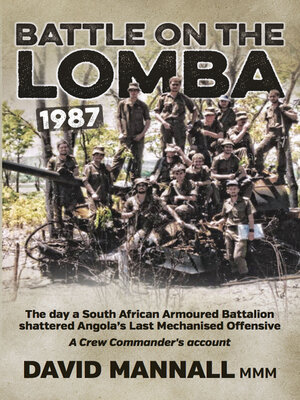
Sign up to save your library
With an OverDrive account, you can save your favorite libraries for at-a-glance information about availability. Find out more about OverDrive accounts.
Find this title in Libby, the library reading app by OverDrive.



Search for a digital library with this title
Title found at these libraries:
| Loading... |
A South African national serviceman recounts becoming a soldier and an ensuing David-and-Goliath face-off against Angolan armed forces in 1987.
The climactic death-throes of Soviet Communism during the 1980s included a last-gasp attempt at strategic franchise expansion in southern Africa. Channeled through Castro's Cuba, oil-rich Angolan armed forces (FAPLA) received billions of dollars of advanced weaponry and thousands of armored vehicles. Their intent: to eradicate the US-backed Angolan opposition (UNITA), then push southwards into South Africa's protectorate SWA/Namibia, ostensibly as liberators.
1985 saw the first large-scale mechanized offensive in southern African history. Russian Generals planned and oversaw the offensive but didn't account for the tenacity of UNITA (supported by the South African Defense Forces, SADF) or the rainy season. The '85 offensive floundered in the mud, and FAPLA returned to their capital Luanda. The South Africans stood down, confident their "covert" support for UNITA had demonstrated the folly of prosecuting war so far from home against Africa's military Superpower. However, they were mistaken. Fidel and FAPLA immediately redoubled their efforts, strengthening fifteen battalions with even more Soviet hardware while Russian and Cuban specialists oversaw troop training.
As Cuban and Angolan fighter pilots honed their skills over the skies of Northern Angola, David Mannall, a normal seventeen-year-old kid completing high school, was preparing for two years of compulsory military service before beginning Tertiary education. Through a series of fateful twists, he found himself leading soldiers in several full-scale armored clashes, including the largest and most decisive battle on African soil since World War II.
This is a David and Goliath story that has never been truthfully told. The author reveals how Charlie Squadron, comprising just twelve 90mm AFVs crewed by thirty-six national servicemen, as part of the elite sixty-one Mechanized Battalion, engaged and effectively annihilated the giant FAPLA 47th Armored Brigade in one day—3 October 1987. Their 90mm cannons were never designed as tank-killers, but any assurances that it would never be used against heavy armor were left in the classroom during the three-month operation and never more starkly than the decisive "Battle on The Lomba River." The Communist-backed offensive died that day along with hundreds of opposition fighters.
47th Brigade survivors abandoned their remaining equipment, eventually joining the 59th Brigade in what became a full-scale retreat of over ten thousand soldiers to Cuito Cuanevale. The myth perpetuated by post-apartheid politicians goes something like this: "The SADF force that destroyed 47th Brigade on 3 October numbered 6,000 men and that all the hard yards were run by the long-suffering UNITA!" The inconvenient truth is that there were just 36 South African boys on the frontline that day, but it is also true to say they would never have achieved such a stunning victory without the support of many more. This is their story.
The climactic death-throes of Soviet Communism during the 1980s included a last-gasp attempt at strategic franchise expansion in southern Africa. Channeled through Castro's Cuba, oil-rich Angolan armed forces (FAPLA) received billions of dollars of advanced weaponry and thousands of armored vehicles. Their intent: to eradicate the US-backed Angolan opposition (UNITA), then push southwards into South Africa's protectorate SWA/Namibia, ostensibly as liberators.
1985 saw the first large-scale mechanized offensive in southern African history. Russian Generals planned and oversaw the offensive but didn't account for the tenacity of UNITA (supported by the South African Defense Forces, SADF) or the rainy season. The '85 offensive floundered in the mud, and FAPLA returned to their capital Luanda. The South Africans stood down, confident their "covert" support for UNITA had demonstrated the folly of prosecuting war so far from home against Africa's military Superpower. However, they were mistaken. Fidel and FAPLA immediately redoubled their efforts, strengthening fifteen battalions with even more Soviet hardware while Russian and Cuban specialists oversaw troop training.
As Cuban and Angolan fighter pilots honed their skills over the skies of Northern Angola, David Mannall, a normal seventeen-year-old kid completing high school, was preparing for two years of compulsory military service before beginning Tertiary education. Through a series of fateful twists, he found himself leading soldiers in several full-scale armored clashes, including the largest and most decisive battle on African soil since World War II.
This is a David and Goliath story that has never been truthfully told. The author reveals how Charlie Squadron, comprising just twelve 90mm AFVs crewed by thirty-six national servicemen, as part of the elite sixty-one Mechanized Battalion, engaged and effectively annihilated the giant FAPLA 47th Armored Brigade in one day—3 October 1987. Their 90mm cannons were never designed as tank-killers, but any assurances that it would never be used against heavy armor were left in the classroom during the three-month operation and never more starkly than the decisive "Battle on The Lomba River." The Communist-backed offensive died that day along with hundreds of opposition fighters.
47th Brigade survivors abandoned their remaining equipment, eventually joining the 59th Brigade in what became a full-scale retreat of over ten thousand soldiers to Cuito Cuanevale. The myth perpetuated by post-apartheid politicians goes something like this: "The SADF force that destroyed 47th Brigade on 3 October numbered 6,000 men and that all the hard yards were run by the long-suffering UNITA!" The inconvenient truth is that there were just 36 South African boys on the frontline that day, but it is also true to say they would never have achieved such a stunning victory without the support of many more. This is their story.






